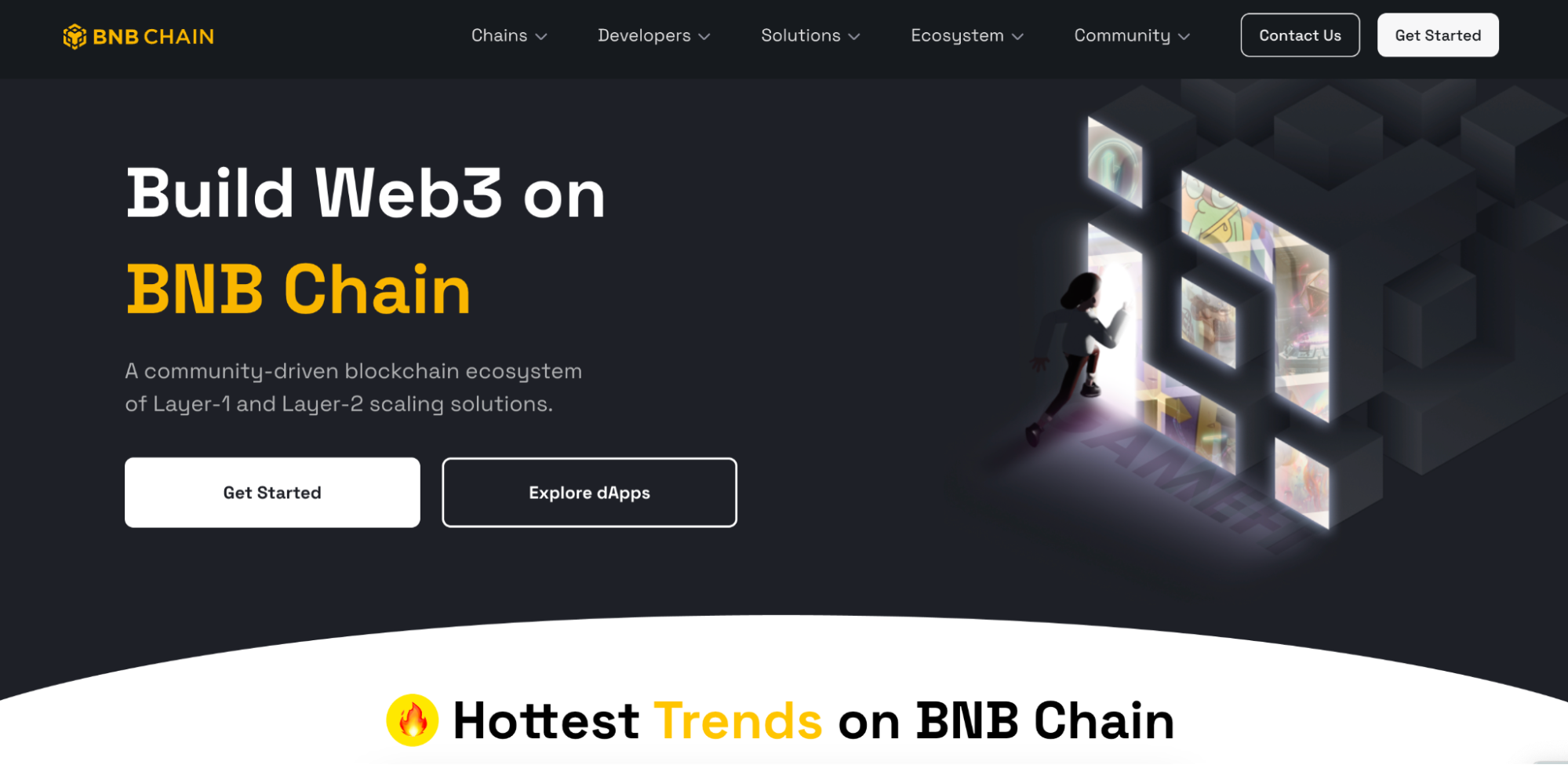Top DeFi di BSC: Wawasan tentang Pengembangan Ekosistem dan Tren Masa Depan
1. Pengenalan
Sejak awal kemunculannya, teknologi blockchain telah menarik perhatian dan eksplorasi secara luas di seluruh dunia dengan karakteristiknya yang terdesentralisasi, tak tergoyahkan, transparan, dan lainnya. Sebagai aplikasi inovatif yang signifikan di bidang blockchain, Keuangan Terdesentralisasi (DeFi) telah mengalami pertumbuhan yang sangat pesat dalam beberapa tahun terakhir dan secara bertahap mengubah lanskap keuangan tradisional.
Keuangan Terdesentralisasi bertujuan untuk membangun sistem keuangan tanpa dukungan institusi terpusat melalui teknologi blockchain, mencakup berbagai bidang seperti pinjaman, perdagangan, asuransi, pengelolaan aset, dll., untuk memberikan pengguna layanan keuangan yang lebih terbuka, efisien, dan adil. Pengguna dapat bebas meminjam, berdagang aset, dan mendapatkan keuntungan di platform DeFi tanpa bergantung pada perantara keuangan tradisional. Model inovatif ini telah menarik sejumlah besar pengembang, investor, dan pengguna untuk berpartisipasi, dan ekosistem DeFi berkembang dengan cepat.
Di antara banyak platform blockchain yang mendukung aplikasi Keuangan Terdesentralisasi (DeFi), Binance Smart Chain (BSC) menonjol dengan keunggulan uniknya, menjadi kekuatan penting dalam ruang DeFi. Diluncurkan oleh bursa kripto terkemuka secara global, Binance, BSC beroperasi paralel dengan Binance Chain, menggabungkan kinerja tinggi dan biaya rendah dari Binance Chain dengan kemampuan kontrak cerdas, mencapai kompatibilitas dengan Ethereum Virtual Machine (EVM). Hal ini memungkinkan pengembang di Ethereum untuk dengan mudah memindahkan proyek mereka ke BSC, secara signifikan mengurangi ambang batas pengembangan dan mempercepat implementasi dan pertumbuhan proyek DeFi di BSC.
BSC memberikan pengalaman yang lebih lancar dan hemat biaya bagi pengguna karena throughput yang tinggi dan biaya transaksi rendah. Menghadapi kemacetan dan biaya tinggi di jaringan Ethereum, BSC menawarkan alternatif yang sangat menarik bagi peserta DeFi. Pada saat yang sama, sebagai bursa kripto global terkemuka, Binance memiliki basis pengguna yang besar dan pengaruh merek yang kuat, memberikan dukungan dan jaminan yang kuat untuk pengembangan BSC, menarik sejumlah besar dana dan proyek ke ekosistemnya.
Dengan munculnya dan perkembangan proyek DeFi secara terus-menerus di BSC, ekosistemnya menjadi semakin kaya dan matang. Mulai dari pertukaran terdesentralisasi (DEX) hingga protokol peminjaman, dari pertambangan likuiditas hingga platform asuransi, berbagai aplikasi DeFi sedang berkembang di BSC, membentuk ekosistem keuangan yang hidup dan inovatif. Beberapa proyek ini telah mencapai kesuksesan signifikan di pasar, menjadi pemimpin industri yang tidak hanya menarik sejumlah besar pengguna untuk berpartisipasi tetapi juga memberikan keuntungan substansial kepada investor.

2. Gambaran Umum BSC
2.1 Pengantar BSC
Binance Smart Chain (BSC) adalah blockchain yang diluncurkan oleh Binance Exchange pada tahun 2020 sejajar dengan Binance Chain. Ia lahir dengan misi untuk mempromosikan ekspansi dan inovasi aplikasi teknologi blockchain. Pada saat itu, gelombang keuangan terdesentralisasi (DeFi) di industri blockchain muncul, dan Ethereum, sebagai platform kontrak pintar utama, menghadapi kemacetan jaringan serius dan biaya transaksi tinggi.
Untuk mengatasi masalah-masalah ini, Binance telah meluncurkan Binance Smart Chain (BSC) dengan memanfaatkan keahlian mendalamnya dan kemampuan teknis yang kuat di bidang cryptocurrency. BSC didasarkan pada mekanisme konsensus Proof of Staked Authority (PoSA), yang memungkinkan node, pemegang token, pengembang, dan pengguna untuk beroperasi dalam ekosistem saling menguntungkan. Di bawah mekanisme PoSA, node mempertaruhkan BNB (Binance Coin) untuk menjadi validator, berpartisipasi dalam validasi blok dan pembangkitan, dan menerima biaya transaksi sebagai imbalan. Dibandingkan dengan mekanisme Proof of Work (PoW) tradisional, mekanisme PoSA secara signifikan meningkatkan efisiensi pemrosesan transaksi, mengurangi konsumsi energi, dan menurunkan hambatan masuk, memungkinkan lebih banyak peserta untuk bergabung dalam jaringan.
Salah satu sorotan teknis terbesar dari BSC adalah kompatibilitasnya dengan Mesin Virtual Ethereum (EVM). Ini berarti bahwa pengembang di Ethereum dapat dengan mudah memigrasikan kontrak pintar dan aplikasi terdesentralisasi (DApps) mereka ke BSC tanpa perlu menulis ulang kode secara ekstensif. Kompatibilitas ini telah membawa sumber daya teknis yang kaya dan komunitas pengembang ke BSC, mempercepat perkembangan ekosistemnya. Sebagai contoh, banyak proyek DeFi yang awalnya berjalan di Ethereum, seperti bursa terdesentralisasi (DEX), protokol peminjaman, dan proyek penambangan likuiditas, telah bermigrasi ke BSC untuk memanfaatkan biaya rendah dan throughput yang tinggi. Selain itu, BSC juga mendukung berbagai perangkat Ethereum, seperti dompet MetaMask, lingkungan pengembangan Remix, dan kerangka kerja Truffle, memungkinkan pengembang untuk melakukan pengembangan proyek dan implementasi dalam lingkungan pengembangan yang familiar, yang lebih lanjut mengurangi biaya dan kesulitan pengembangan.
Karakteristik dan keunggulan dari 2.2 BSC
- Kinerja Tinggi: Kecepatan pemrosesan transaksi BSC sangat cepat, memproses ribuan transaksi per detik rata-rata, dengan waktu konfirmasi blok hanya sekitar 3 detik. Kinerja tinggi ini dikaitkan dengan mekanisme konsensus PoSA yang unik dan arsitektur teknis canggihnya. Dalam jaringan blockchain tradisional seperti Ethereum, mekanisme konsensus PoW membutuhkan jumlah sumber daya komputasi yang signifikan untuk bersaing mendapatkan hak untuk mencatat transaksi, sehingga mengakibatkan kecepatan pemrosesan transaksi yang lebih lambat dan rentan terhadap kemacetan jaringan. Di sisi lain, mekanisme PoSA BSC memilih validator dengan melakukan staking BNB, meningkatkan efisiensi konsensus secara signifikan, memungkinkan transaksi dikonfirmasi dan diproses dengan cepat. Fitur kinerja tinggi ini memungkinkan BSC memenuhi kebutuhan skenario aplikasi berskala besar, memberikan pengguna pengalaman pengguna yang lancar. Misalnya, dalam bursa terdesentralisasi, waktu konfirmasi transaksi yang cepat dapat memastikan transaksi pengguna dieksekusi tepat waktu, menghindari risiko fluktuasi harga akibat keterlambatan transaksi.
- Biaya Rendah: Dibandingkan dengan rantai publik seperti Ethereum, BSC memiliki biaya transaksi yang sangat rendah, serendah sekitar 1 sen. Hal ini terutama karena mekanisme konsensus PoSA tidak memerlukan konsumsi energi dan investasi perangkat keras yang besar, sehingga mengurangi biaya operasional. Bagi pengguna, biaya rendah berarti mereka dapat melakukan perdagangan lebih sering tanpa khawatir tentang biaya transaksi tinggi. Keuntungan biaya rendah di BSC ini terutama terasa bagi pedagang kecil dan berfrekuensi tinggi. Misalnya, saat melakukan transfer kriptokurensi kecil atau berpartisipasi dalam pertambangan likuiditas, biaya pengguna di BSC jauh lebih rendah daripada di Ethereum, memungkinkan lebih banyak pengguna untuk berpartisipasi dalam ekosistem DeFi.
- Skalabilitas: BSC memiliki skalabilitas yang baik, mampu mendukung sejumlah besar pengguna dan aplikasi. Dengan menggunakan teknologi sharding dan arsitektur jaringan yang dioptimalkan, BSC dapat menampung lebih banyak transaksi dan pengguna tanpa mengorbankan kinerja. Sharding membagi jaringan blockchain menjadi beberapa shard, masing-masing mampu memproses transaksi secara independen, dengan demikian meningkatkan throughput jaringan secara keseluruhan dan kapasitas pemrosesan. Skalabilitas ini merupakan dasar yang kokoh untuk pengembangan masa depan BSC, memungkinkannya memenuhi tuntutan pasar yang semakin meningkat. Dengan popularitas aplikasi DeFi yang semakin meningkat dan jumlah pengguna yang bertambah, keunggulan skalabilitas BSC akan semakin terlihat, menarik lebih banyak proyek dan pengguna untuk bergabung ke dalam ekosistemnya.
- Sumber daya ekologis yang kaya: Sebagai salah satu bursa kripto terbesar di dunia, Binance memiliki basis pengguna yang besar dan sumber daya ekologis yang kaya. BSC, sebagai bagian penting dari ekosistem Binance, mendapat manfaat dari pengaruh merek Binance dan dukungan sumber daya. Binance memberikan berbagai dukungan untuk proyek-proyek di BSC, termasuk bimbingan teknis, pemasaran, dan dukungan keuangan. Sementara itu, integrasi yang dalam antara BSC dan Binance Exchange memungkinkan pengguna untuk dengan mudah melakukan perdagangan aset di BSC di Binance Exchange, yang lebih meningkatkan likuiditas aset dan efisiensi pasar.
- Interoperabilitas lintas-rantai: BSC mendukung teknologi lintas-rantai, memungkinkan interoperabilitas dengan jaringan blockchain lainnya. Ini berarti bahwa pengguna dapat dengan mudah mentransfer dan memanfaatkan aset dari blockchain lain di BSC, memperluas kegunaan dan likuiditas aset.
2.3 BSC dibandingkan dengan rantai publik lainnya
1. Bandingkan dengan Ethereum
- Dalam hal kinerja: Ethereum mengadopsi mekanisme konsensus PoW, yang mengakibatkan pemrosesan transaksi yang lambat di awal, dengan rata-rata hanya beberapa transaksi per detik. Seiring dengan peningkatan jumlah pengguna dan aplikasi, kemacetan jaringan menjadi semakin parah. Meskipun Ethereum sedang beralih ke mekanisme konsensus PoS dan menggunakan teknologi seperti Layer 2 untuk meningkatkan kinerja, pada tahap saat ini, kecepatan pemrosesan transaksinya masih jauh tertinggal dari BSC. Mekanisme konsensus PoSA BSC memungkinkan untuk mencapai kapasitas pemrosesan transaksi ribuan transaksi per detik, dengan waktu konfirmasi blok hanya 3 detik, memberikan keunggulan kinerja yang signifikan.
- Biaya: Biaya transaksi di jaringan Ethereum sangat bervariasi. Selama kemacetan jaringan, biaya dapat meningkat tajam, bahkan mencapai puluhan dolar. Hal ini membuat sulit bagi banyak transaksi kecil dan pengguna reguler untuk mampu. Di sisi lain, biaya transaksi BSC sangat rendah, biasanya hanya beberapa sen, sangat mengurangi biaya transaksi bagi pengguna, terutama bagi pengguna reguler dan transaksi kecil.
- Ekosistem: Ethereum memiliki ekosistem Keuangan Terdesentralisasi (DeFi) terbesar dan paling matang, mengumpulkan sejumlah besar pengembang dan proyek, dengan aplikasi yang mencakup berbagai area seperti keuangan, gaming, sosial, dan lainnya. Namun, dengan munculnya BSC, ekosistemnya juga tumbuh dan berkembang dengan cepat. Dengan memanfaatkan keunggulan kinerja dan biaya, BSC telah menarik sejumlah besar proyek Ethereum untuk bermigrasi dan menarik proyek-proyek baru untuk menetap, membentuk ekosistem DeFi yang relatif lengkap. Di beberapa area seperti pertukaran terdesentralisasi, penambangan likuiditas, dll., BSC telah membentuk posisi kompetitif dengan ekosistem Ethereum.
2. Dibandingkan dengan Polkadot
- Arsitektur Teknis: Polkadot adalah platform lintas-rantai yang mengadopsi arsitektur unik dari rantai relay dan parachain, bertujuan untuk mencapai interoperabilitas dan keamanan bersama antara berbagai blockchain yang berbeda. Polkadot dirancang untuk membangun ekosistem multi-rantai, di mana setiap parachain dapat menyesuaikan mekanisme konsensus dan fungsionalitas yang berbeda sesuai dengan kebutuhannya sendiri. Di sisi lain, BSC adalah blockchain independen yang terutama menarik pengguna dan proyek melalui kompatibilitasnya dengan Ethereum dan kinerja tinggi. Meskipun BSC juga mendukung teknologi lintas-rantai, masih ada kesenjangan tertentu dibandingkan dengan Polkadot dalam hal kompleksitas dan keragaman lintas-rantai.
- Kasus Penggunaan: Fitur lintas-rantai Polkadot membuatnya lebih fokus pada interaksi dan kolaborasi antara blockchain yang berbeda, memberikan dukungan kuat untuk pengembangan aplikasi lintas-rantai.
- Pengembangan ekosistem: Ekosistem Polkadot sedang dalam tahap pengembangan yang cepat, menarik banyak proyek dan pengembang untuk berpartisipasi. Proyek-proyek dalam ekosistemnya mencakup berbagai bidang termasuk keuangan, Internet of Things, dan verifikasi identitas. Sementara itu, ekosistem BSC berputar di sekitar DeFi sebagai inti, membangun ekosistem lengkap seputar DeFi, termasuk pertukaran terdesentralisasi, protokol peminjaman, penambangan likuiditas, asuransi, dan berbagai aplikasi lainnya. Saat ini, arah pengembangan kedua ekosistem tersebut agak berbeda, tetapi keduanya terus memperluas dan meningkatkan lanskap ekosistem mereka sendiri.
3. Bandingkan dengan Solana
- Kinerja: Solana juga adalah rantai publik yang dikenal karena kinerjanya yang tinggi. Mekanisme konsensus hibridanya antara Proof of History (PoH) dan Proof of Stake (PoS) memungkinkannya mencapai kecepatan pemrosesan transaksi hingga 65.000 transaksi per detik (TPS) dan waktu konfirmasi transaksi yang sangat singkat. Dibandingkan dengan BSC, Solana memiliki keunggulan yang lebih kuat dalam hal kinerja. Namun, kinerja BSC dalam aplikasi sebenarnya sudah cukup memenuhi kebutuhan sebagian besar aplikasi DeFi, dan kompatibilitasnya dengan Ethereum memberikan kenyamanan tambahan kepada pengembang dan pengguna.
- Fitur ekologis: Ekosistem Solana berkembang dengan cepat, menarik banyak proyek inovatif, terutama di bidang Keuangan Terdesentralisasi (DeFi) dan NFT. Proyek-proyek di Solana fokus pada inovasi teknologi dan pengalaman pengguna, seperti pertukaran terdesentralisasi berkinerja tinggi dan proyek NFT unik. Ekosistem BSC, didukung oleh sumber daya Binance dan kompatibilitasnya dengan Ethereum, telah menarik sejumlah besar proyek DeFi matang untuk bermigrasi dan proyek-proyek baru untuk bergabung, memberikannya keunggulan tertentu dalam kekayaan dan stabilitas ekosistemnya.
- Komunitas dan Basis Pengguna: Solana memiliki komunitas teknis yang aktif, menarik banyak pengembang dan pengguna yang mengejar kinerja tinggi dan teknologi inovatif. BSC, memanfaatkan basis pengguna besar Binance dan pengaruh global, memiliki basis pengguna yang luas, terutama di wilayah Asia. Keduanya memiliki karakteristik masing-masing dalam hal komunitas dan basis pengguna, dan terus memperluas pengaruh mereka.
3. Analisis Proyek DeFi Teratas di BSC
3.1 PancakeSwap
PancakeSwap adalah pertukaran terdesentralisasi (DEX) yang dibangun di Binance Smart Chain (BSC). Sejak diluncurkan pada September 2020, dengan fitur inovatif dan operasi yang efisien, PancakeSwap dengan cepat muncul di bidang DeFi, menjadi salah satu proyek paling berpengaruh dan ramah pengguna di BSC.
Dalam hal mekanisme perdagangan, PancakeSwap mengadopsi model Automated Market Maker (AMM), yang merupakan mekanisme inovatif yang berbeda dari perdagangan buku pesanan tradisional. Di bawah model AMM, perdagangan tidak diselesaikan dengan mencocokkan pesanan secara langsung antara pembeli dan penjual tetapi berdasarkan pada kolam likuiditas. Pengguna menyetor dua token berbeda ke dalam kolam likuiditas untuk membentuk pasangan perdagangan, seperti BNB - USDT. Rasio token dalam kolam likuiditas secara otomatis disesuaikan berdasarkan situasi perdagangan, dan harga perdagangan ditentukan oleh rumus matematika (biasanya rumus produk konstan, yaitu x * y = k, di mana x dan y mewakili jumlah dua token, dan k adalah konstan). Mekanisme ini membuat perdagangan lebih nyaman dan efisien, karena pengguna dapat melakukan perdagangan kapan saja tanpa harus menunggu pesanan lawan. Pada saat yang sama, model AMM juga menyediakan likuiditas yang berkelanjutan ke pasar, mengurangi slippage perdagangan, dan meningkatkan efisiensi eksekusi perdagangan. Sebagai contoh, ketika seorang pengguna ingin menukar BNB dengan USDT, mereka hanya perlu memilih pasangan perdagangan yang sesuai di PancakeSwap, memasukkan jumlah pertukaran, dan perdagangan dapat segera diselesaikan, dengan harga perdagangan secara otomatis dihitung berdasarkan situasi real-time dalam kolam likuiditas.
Selain fungsi perdagangan dasar, PancakeSwap telah memperkenalkan mekanisme pertambangan likuiditas dan yield farming yang kaya, memberikan pengguna beberapa cara untuk mendapatkan keuntungan. Pengguna dapat mendapatkan bagian dari biaya perdagangan sebagai imbalan dengan menyediakan likuiditas ke dalam kolam likuiditas. Secara khusus, setiap kali transaksi terjadi, persentase tertentu (biasanya 0,25%) dari biaya perdagangan akan dialokasikan kepada penyedia likuiditas (LP). Sebagai contoh, jika jumlah transaksi adalah $1000, berdasarkan tarif biaya 0,25%, $2,5 biaya akan didistribusikan kepada penyedia likuiditas dari pasangan perdagangan tersebut. Selain itu, PancakeSwap telah memperkenalkan fitur-fitur unik seperti Kolam Sirup dan Peternakan. Di Kolam Sirup, pengguna dapat melakukan staking CAKE (token governance asli PancakeSwap) untuk mendapatkan imbalan CAKE tambahan. Di Peternakan, pengguna dapat mendepositokan token LP, berpartisipasi dalam pertambangan likuiditas, dan mendapatkan imbalan CAKE dan token lainnya. Peternakan yang berbeda mungkin menawarkan hasil dan tingkat risiko yang bervariasi, memungkinkan pengguna untuk memilih berdasarkan preferensi risiko dan harapan keuntungan mereka. Sebagai contoh, sebuah Peternakan mungkin memberikan hasil tahunan yang lebih tinggi tetapi juga datang dengan risiko volatilitas pasar yang lebih tinggi, sementara Peternakan lain mungkin memiliki hasil yang relatif lebih rendah tetapi risiko yang lebih stabil. Mekanisme yield farming yang terdiversifikasi ini telah menarik sejumlah besar pengguna, yang lebih meningkatkan likuiditas dan aktivitas platform.
Keberhasilan PancakeSwap tidak hanya karena mekanisme perdagangan inovatif dan model pendapatan yang kaya, tetapi juga erat kaitannya dengan kinerja tinggi dan biaya transaksi rendah dari Binance Smart Chain. Waktu konfirmasi transaksi yang cepat dan biaya transaksi rendah dari BSC memungkinkan pengguna menikmati pengalaman perdagangan yang lancar di PancakeSwap tanpa perlu khawatir tentang biaya tinggi dan keterlambatan transaksi. Pada saat yang sama, PancakeSwap secara aktif memperluas kerjasama ekologisnya, menjalin kemitraan dengan berbagai proyek dan meluncurkan berbagai aplikasi inovatif termasuk lotere, perdagangan NFT, pasar prediksi, dll., yang lebih memperkaya skenario pengguna dan pengalaman pengguna. Sebagai contoh, fitur lotere PancakeSwap memungkinkan pengguna untuk berpartisipasi dalam lotere menggunakan CAKE dan memiliki kesempatan untuk memenangkan hadiah substansial; platform perdagangan NFT menyediakan pengguna dengan saluran baru untuk perdagangan aset digital, mempromosikan pengembangan pasar NFT.

Login ke platform perdagangan Gate.io untuk melakukan perdagangan token CAKE:https://www.gate.io/trade/CAKE_USDT
3.2 Venus
Venus adalah protokol pasar uang algoritmik dan stablecoin yang berjalan di Binance Smart Chain (BSC), yang menggabungkan mekanisme pencetakan stablecoin MakerDAO dengan pasar uang algoritmik Compound secara inovatif, bertujuan untuk menyediakan layanan keuangan terdesentralisasi yang efisien dan nyaman bagi pengguna, menduduki posisi penting dalam ekosistem DeFi di BSC.
Salah satu fungsi inti Venus adalah layanan pencetakan dan peminjaman stablecoin VAI. Dalam hal pencetakan stablecoin, Venus mengadopsi metode over-collateralization. Pengguna perlu menyetor sejumlah aset kripto (seperti BNB, BTCB, dll.) sebagai jaminan ke dalam protokol Venus. Kemudian, berdasarkan nilai aset jaminan dan rasio agunan yang ditetapkan oleh sistem, mereka dapat mencetak jumlah stablecoin VAI yang sesuai, yang dipatok menjadi 1 dolar AS. Mekanisme ini mirip dengan bagaimana MakerDAO mencetak stablecoin DAI, tetapi fitur unik Venus adalah pelepasan likuiditas dari aset jaminan. Di MakerDAO, ketika pengguna mencetak DAI, aset jaminan dikunci dan tidak dapat digunakan untuk tujuan lain. Sebaliknya, di Venus, aset jaminan ini dapat digunakan sebagai jaminan di pasar pinjaman, menyediakan pengguna dengan layanan pinjaman, mirip dengan menyediakan likuiditas sebagai penyedia likuiditas (LP) pada platform Compound dan mendapatkan pendapatan. Inovasi ini menjadikan Venus tidak hanya platform pencetakan stablecoin tetapi juga pasar pasokan likuiditas yang komprehensif, meningkatkan efisiensi pemanfaatan aset. Misalnya, Pengguna A memiliki 10 BNB, yang mereka jaminkan ke dalam protokol Venus. Dengan asumsi rasio agunan 150%, mereka dapat mencetak stablecoin VAI senilai sekitar 6,67 BNB (10 / 1,5). Pada saat yang sama, 10 BNB ini juga dapat digunakan sebagai jaminan untuk operasi pinjaman di Venus.
Dalam bisnis pinjaman, Venus menyediakan pengguna dengan opsi pinjaman dan peminjaman yang fleksibel. Peminjam dapat meminjam VAI atau mata uang kripto lain yang didukung dengan jaminan aset, sementara pemberi pinjaman dapat menyetor dana tidak terpakai mereka ke Venus untuk menyediakan likuiditas ke pasar pinjaman dan mendapatkan pendapatan bunga yang sesuai. Tingkat bunga pinjaman disesuaikan secara dinamis berdasarkan pasokan dan permintaan pasar untuk memastikan keseimbangan dan stabilitas pasar. Sebagai contoh, ketika ada permintaan tinggi untuk VAI di pasar, tingkat bunga pinjaman akan meningkat secara sesuai untuk menarik lebih banyak pemberi pinjaman untuk menyediakan dana; sebaliknya, ketika permintaan rendah, tingkat bunga akan turun. Mekanisme penyesuaian tingkat bunga yang didorong oleh pasar ini memungkinkan pasar pinjaman Venus beroperasi lebih efisien.
Venus memiliki keunggulan signifikan. Integrasi mendalamnya dengan BSC memungkinkan biaya transaksi rendah dan kecepatan transaksi yang cepat, memberikan pengalaman perdagangan yang baik bagi pengguna. Venus memperkuat manajemen risiko dengan memperkenalkan kolam terisolasi, parameter risiko yang lebih kompleks, mendirikan dana risiko, dan mekanisme penanganan utang buruk, secara efektif melindungi terhadap kejadian angsa hitam, dan menjaga dana pengguna. Model tata kelola Venus terus meningkat dengan memperkenalkan fitur seperti VIP jalur cepat, kontrol akses berbasis peran, dan mekanisme jeda halus, meningkatkan desentralisasi dan memungkinkan pengguna untuk berpartisipasi lebih langsung dalam tata kelola platform.
Namun, Venus juga menghadapi beberapa tantangan. Persaingan pasar sangat sengit, dengan perkembangan industri Keuangan Terdesentralisasi (DeFi), semakin banyak protokol peminjaman dan proyek stablecoin muncul. Venus perlu terus berinovasi dan mengoptimalkan untuk menjaga keunggulan kompetitifnya. Volatilitas tinggi pasar cryptocurrency menguji nilai aset jaminan Venus dan stabilitas stablecoin yang diikat. Penurunan signifikan dalam harga aset jaminan dapat menyebabkan jaminan yang tidak mencukupi, memengaruhi stabilitas stablecoin dan operasi normal platform. Risiko kontrak pintar juga merupakan ancaman potensial. Meskipun Venus telah menjalani beberapa audit kode yang ketat, kemungkinan adanya kerentanan kontrak pintar tidak dapat sepenuhnya dihilangkan. Begitu terjadi insiden keamanan, akan menyebabkan kerugian yang signifikan bagi pengguna dan platform.

Login ke platform perdagangan Gate.io untuk melakukan perdagangan token XVS:https://www.gate.io/trade/XVS_USDT
3.4 Alpaca Finance
Alpaca Finance adalah protokol pertanian imbal hasil berdaya ungkit yang dibangun di Binance Smart Chain (BSC), memberikan pengguna cara inovatif untuk menghasilkan keuntungan. Dengan memperkenalkan mekanisme leverage, pengguna dapat mencapai hasil yang lebih tinggi di pasar kripto, sambil juga membawa risiko dan peluang unik, memegang posisi penting dalam ekosistem DeFi BSC.
Prinsip inti dari Alpaca Finance adalah pertanian hasil leverage. Pengguna dapat memberi jaminan sejumlah aset kripto (seperti BNB, BUSD, dll.) di platform sebagai margin, meminjam aset tambahan, dan kemudian mendeploy aset tersebut ke dalam penambangan likuiditas atau kegiatan pertanian hasil lainnya untuk memperbesar pengembalian. Sebagai contoh, Pengguna A memiliki 1000 USD bernilai BUSD, yang mereka berikan jaminan di platform Alpaca Finance. Dengan asumsi leverage platform adalah 3x, Pengguna A dapat meminjam 2000 USD aset (biasanya aset lain dalam pasangan perdagangan yang terkait dengan aset yang dijamin, seperti BNB). Pengguna A menggabungkan 2000 USD yang dipinjam aset BNB dengan 1000 USD asli mereka yang bernilai BUSD untuk membentuk pasangan likuiditas, dan kemudian mendepositkannya ke dalam kolam likuiditas khusus untuk pertambangan. Jika hasil tahunan kolam likuiditas adalah 20%, tanpa leverage, pengembalian tahunan Pengguna A akan menjadi 100020% = $200. Dengan leverage 3x, investasi total Pengguna A menjadi $3000, dengan pengembalian tahunan sebesar $300020% = $600. Setelah dikurangi bunga pinjaman, pendapatan sebenarnya Pengguna A akan meningkat secara signifikan.
ALPACA adalah token asli dari platform Alpaca Finance dengan fungsi-fungsi ganda. Token ini digunakan untuk berbagi hadiah penambangan, di mana pengguna menerima bagian dari hadiah dalam bentuk ALPACA saat berpartisipasi dalam pertanian hasil ungkit di platform. Token ALPACA juga digunakan untuk hadiah, seperti berpartisipasi dalam tata kelola platform, menyelesaikan tugas-tugas tertentu, atau mencapai tingkat aktivitas perdagangan tertentu, yang semuanya dapat menghasilkan hadiah ALPACA. Dalam hal tata kelola jaringan, pemegang token ALPACA memiliki hak suara untuk membuat keputusan penting bagi platform, seperti penyesuaian parameter, peluncuran fitur baru, dll., sehingga memengaruhi arah pengembangan platform. ALPACA juga menawarkan izin NFT eksklusif, di mana pengguna yang memegang sejumlah ALPACA tertentu dapat memperoleh NFT eksklusif platform yang mungkin memiliki hak istimewa atau makna simbolis.
Fitur pendapatan dari Alpaca Finance adalah potensi untuk mendapatkan keuntungan tinggi, tetapi juga memiliki risiko tinggi. Di satu sisi, penggunaan leverage memperbesar keuntungan, memberikan kesempatan kepada pengguna untuk mencapai keuntungan lebih tinggi daripada pendapatan farming tradisional saat kondisi pasar menguntungkan. Di pasar bullish, banyak pengguna yang menggunakan leverage untuk yield farming telah memperoleh beberapa kali lipat atau bahkan puluhan kali lipat keuntungan. Di sisi lain, leverage juga memperbesar risiko. Jika kondisi pasar tidak menguntungkan dan harga aset turun, pengguna tidak hanya dapat kehilangan semua pendapatan pertambangan mereka, tetapi juga menghadapi risiko margin yang tidak mencukupi, mengakibatkan likuidasi jaminan dan kerugian pokok. Fluktuasi pasar, risiko kontrak pintar, risiko likuidasi, dll., juga merupakan tantangan yang perlu dihadapi pengguna. Sebagai contoh, jika harga aset jaminan tiba-tiba turun secara signifikan selama proses pertambangan ber-leverage, ketika rasio margin lebih rendah dari garis likuidasi yang ditetapkan platform, platform akan secara otomatis melakukan likuidasi aset jaminan pengguna untuk melunasi pinjaman, dan pengguna dapat menderita kerugian yang signifikan sebagai akibatnya. Selain itu, kerentanan kontrak pintar juga dapat menyebabkan masalah keamanan, meskipun Alpaca Finance telah melalui pemeriksaan yang ketat, risiko kontrak pintar tidak dapat sepenuhnya dihilangkan.

Masuk ke platform perdagangan Gate.io untuk melakukan perdagangan token ALPACA:https://www.gate.io/trade/ALPACA_USDT
4. Dampak dari proyek DeFi teratas pada ekosistem BSC
4.1 Memajukan perkembangan dan kemakmuran ekosistem BSC
Proyek DeFi teratas memainkan peran kunci dalam ekosistem BSC, sangat mendorong perkembangannya dan kemakmuran. Proyek-proyek ini telah menarik aliran dana besar ke dalam ekosistem BSC. Mengambil PancakeSwap sebagai contoh, sebagai salah satu bursa terdesentralisasi terbesar di BSC, Total Value Locked (TVL)-nya telah dipertahankan pada level tinggi untuk waktu yang lama. Selama periode pasar aktif, TVL PancakeSwap telah melebihi miliaran dolar, menarik investor dari seluruh dunia untuk menyediakan likuiditas ke dalam poolnya. Dana-dana ini tidak hanya memberikan dasar keuangan yang kokoh untuk pengembangan proyek itu sendiri, tetapi juga mendorong aliran dana secara keseluruhan dalam ekosistem BSC, mempromosikan perkembangan proyek lain. Venus, sebagai protokol peminjaman, telah menarik sejumlah besar pengguna untuk mendepositkan aset ke dalam platform dengan menyediakan layanan peminjaman yang dijaminkan, lebih meningkatkan total jumlah dana dalam ekosistem BSC.
Dalam hal menarik pengguna, proyek Keuangan Terdesentralisasi terkemuka telah menarik sejumlah besar pengguna dengan fitur-fitur kaya dan model-model inovatif mereka. PancakeSwap menyediakan berbagai fungsi seperti pertambangan likuiditas dan perdagangan, memenuhi beragam kebutuhan pengguna. Menurut statistik, PancakeSwap memiliki ratusan ribu pengguna aktif harian, dengan basis pengguna kumulatif mencapai jutaan. Pengguna ini berasal tidak hanya dari kalangan investor profesional cryptocurrency tetapi juga melibatkan sejumlah besar pengguna biasa. Dengan berpartisipasi dalam berbagai kegiatan di PancakeSwap, mereka telah merasakan secara mendalam pesona Keuangan Terdesentralisasi dan kemudian tinggal di ekosistem BSC. Layanan peminjaman Venus juga telah menarik banyak pengguna dengan kebutuhan pendanaan dan manajemen keuangan, menyediakan solusi keuangan yang nyaman bagi mereka, yang lebih lanjut memperluas basis pengguna ekosistem BSC.
Pertumbuhan komunitas pengembang juga merupakan salah satu kontribusi penting dari proyek DeFi teratas untuk ekosistem BSC. Proyek-proyek ini menyediakan sumber daya pengembangan yang kaya dan ruang inovasi yang luas bagi para pengembang. Kode sumber terbuka PancakeSwap dan antarmuka API terbuka memungkinkan para pengembang melakukan pengembangan sekunder berdasarkan platformnya, menciptakan berbagai aplikasi turunan dan alat. Banyak pengembang melihat potensi PancakeSwap dan telah aktif berpartisipasi dalam pengembangan proyek terkait, membentuk komunitas pengembang yang besar. Para pengembang ini tidak hanya menyediakan dukungan teknis yang berkelanjutan dan kekuatan inovasi bagi pengembangan PancakeSwap tetapi juga menerapkan pengalaman pengembangan dan teknologi mereka pada proyek lain dalam ekosistem BSC, mempromosikan kemajuan teknologi dan pengembangan inovatif dari seluruh ekosistem. Sebagai contoh, beberapa pengembang telah mengembangkan alat perdagangan yang lebih efisien dan platform analisis data berdasarkan PancakeSwap, meningkatkan pengalaman dan efisiensi pengguna dalam perdagangan DeFi.
Meningkatkan daya saing pasar BSC
Proyek DeFi teratas telah secara signifikan meningkatkan daya saing BSC di pasar rantai publik. Dalam hal kinerja dan pengalaman pengguna, proyek DeFi teratas yang diwakili oleh PancakeSwap telah sepenuhnya memanfaatkan kinerja tinggi dan karakteristik biaya transaksi rendah dari BSC. PancakeSwap memiliki kecepatan pemrosesan transaksi yang sangat cepat, memungkinkan pesanan dikonfirmasi dan dieksekusi dalam waktu singkat, sangat meningkatkan efisiensi transaksi. Sekaligus, biaya transaksi rendahnya berarti bahwa pengguna tidak perlu menanggung biaya tinggi saat melakukan perdagangan secara sering, berbeda jauh dengan biaya transaksi tinggi dan kemacetan transaksi yang dihadapi oleh rantai publik seperti Ethereum selama periode puncak. Selama kemacetan jaringan Ethereum, biaya transaksi untuk satu transaksi dapat mencapai beberapa dolar atau bahkan lebih tinggi, dan waktu konfirmasi transaksi dapat mencapai beberapa menit atau bahkan puluhan menit; sedangkan di PancakeSwap, biaya transaksi untuk jumlah transaksi yang serupa hanya beberapa sen, dan waktu konfirmasi transaksi hanya membutuhkan beberapa detik. Pengalaman perdagangan yang efisien dan murah ini telah menarik sejumlah besar pengguna dan proyek yang awalnya ada di rantai publik seperti Ethereum, membuat BSC menonjol di pasar rantai publik.
Dalam hal inovasi proyek dan kekayaan ekosistem, proyek DeFi teratas terus memperkenalkan model bisnis inovatif dan kasus penggunaan baru, memperkaya konten ekosistem BSC. Protokol pertanian hasil leverage yang diperkenalkan oleh Alpaca Finance memberikan pengguna cara baru untuk menghasilkan pendapatan, menarik banyak pengguna yang mencari hasil tinggi dengan memperbesar keuntungan melalui leverage. Model inovatif ini tidak hanya memberikan lebih banyak pilihan investasi kepada pengguna tetapi juga memberikan gagasan dan arah baru untuk pengembangan industri DeFi. Sistem rekomendasi tiga tingkat Biswap secara inovatif memanfaatkan hubungan sosial dan komunikasi dari mulut ke mulut di antara pengguna, mencapai pertumbuhan pengguna yang cepat dan promosi proyek yang luas. Kemunculan proyek-proyek inovatif ini telah membuat ekosistem BSC lebih beragam, menarik lebih banyak pengembang dan proyek untuk menetap, lebih meningkatkan daya saing pasar BSC. Sebagai contoh, beberapa proyek DeFi yang muncul yang terinspirasi oleh Alpaca Finance dan Biswap telah mengembangkan aplikasi inovatif serupa di BSC, seperti proyek pertanian hasil dengan strategi leverage yang berbeda, dan proyek layanan keuangan berdasarkan rekomendasi sosial, yang lebih memperkaya lanskap ekologis BSC.
Risiko dan Tantangan yang Dibawa oleh 4.3
Proyek DeFi teratas membawa peluang pengembangan ke ekosistem BSC, serta serangkaian risiko dan tantangan. Dalam hal risiko keamanan, kerentanan kontrak pintar adalah isu yang menonjol. Kode kontrak pintar dari banyak proyek DeFi kompleks, dan meskipun telah mengalami beberapa audit, masih sulit untuk sepenuhnya menghilangkan keberadaan kerentanan. Sebagai contoh, pada Mei 2021, PancakeBunny mengalami serangan pinjaman kilat, di mana penyerang memanipulasi harga pool PancakeSwap USDT - BNB V1 melalui kerentanan kontrak pintar, menyebabkan sejumlah besar BNB mengalir ke pool BNB - Bunny, secara ilegal memperoleh aset senilai sekitar 40 juta dolar AS. Serangan ini tidak hanya menyebabkan kerugian signifikan bagi pengguna proyek PancakeBunny, tetapi juga berdampak negatif pada reputasi ekosistem BSC. Manajemen kunci pribadi yang tidak benar juga dapat menyebabkan pencurian aset pengguna. Jika kunci pribadi pengguna bocor, penyerang dapat dengan mudah mentransfer aset pengguna dalam proyek DeFi, menyebabkan kerugian finansial langsung bagi pengguna.
Risiko volatilitas pasar juga tidak boleh diabaikan. Pasar cryptocurrency memiliki tingkat volatilitas yang tinggi, dan proyek DeFi di BSC juga tidak kebal. Ambil Venus sebagai contoh, nilai aset jaminan dalam bisnis pemberi pinjamanannya akan berubah seiring dengan fluktuasi pasar. Pada saat pasar mengalami penurunan, nilai aset jaminan dapat menyusut secara signifikan, menyebabkan jaminan yang tidak mencukupi dan pengguna menghadapi risiko likuidasi. Jika sejumlah besar pengguna dilikuidasi pada saat yang bersamaan, hal ini dapat memicu kepanikan pasar, lebih memperparah volatilitas pasar. Fluktuasi suku bunga pasar juga akan memengaruhi tingkat pinjaman dan pengembalian proyek DeFi, membawa ketidakpastian bagi investor. Jika suku bunga pasar tiba-tiba naik, biaya pinjaman akan meningkat, berpotensi menyebabkan penurunan pengembalian beberapa proyek pemberi pinjaman, mempengaruhi antusiasme investor.
Tantangan terhadap stabilitas ekosistem BSC juga ada. Perkembangan cepat proyek DeFi terkemuka dapat menyebabkan kemacetan pada jaringan BSC. Dengan peningkatan terus-menerus pengguna dan volume transaksi, kapasitas pemrosesan jaringan dapat mengalami tekanan. Ketika jaringan sedang macet, waktu konfirmasi transaksi akan memanjang, dan biaya juga akan meningkat, memengaruhi pengalaman pengguna dan berpotensi menyebabkan beberapa proyek mengalami disfungsi. Kemakmuran berlebihan beberapa proyek DeFi tertentu dapat menarik konsentrasi dana dan sumber daya, menyebabkan perkembangan ekosistem menjadi tidak seimbang. Jika suatu proyek menguasai terlalu banyak sumber daya, dapat mempersempit ruang hidup proyek lain, memengaruhi perkembangan sehat seluruh ekosistem.

5. Tren pengembangan proyek DeFi di BSC
5.1 Tren Inovasi Teknologi
Dalam proyek DeFi di BSC, teknologi lintas-rantai menjadi kekuatan kunci yang mendorong perkembangan ekosistem. Dengan perkembangan industri blockchain, permintaan akan interoperabilitas aset dan data antar blockchain yang berbeda semakin meningkat. Teknologi lintas-rantai dapat mengatasi hambatan antar blockchain, memungkinkan aliran bebas aset dan berbagi data, membawa peluang pengembangan yang lebih luas bagi proyek-proyek DeFi. Banyak proyek DeFi di BSC mulai memperkenalkan teknologi lintas-rantai, mencapai interoperabilitas dengan rantai publik utama lainnya seperti Ethereum dan Polkadot. Melalui jembatan lintas-rantai, pengguna dapat mentransfer aset dari Ethereum ke BSC untuk berpartisipasi dalam aplikasi DeFi di ekosistem BSC, dan sebaliknya. Hal ini tidak hanya meningkatkan likuiditas aset tetapi juga memperkaya pilihan pengguna, mempromosikan integrasi antara ekosistem blockchain yang berbeda.
Peningkatan kontrak pintar juga merupakan arah pengembangan teknis yang penting untuk proyek Keuangan Terdesentralisasi BSC. Dengan perluasan skenario aplikasi yang berkelanjutan dan meningkatnya kompleksitas permintaan pengguna, kontrak pintar perlu terus dioptimalkan dan ditingkatkan untuk meningkatkan kinerja, meningkatkan keamanan, dan memperkaya fungsionalitas. Pengembang menggunakan berbagai cara teknis untuk mencapai peningkatan kontrak pintar. Metode umum adalah menggunakan pola kontrak proxy untuk memisahkan logika dan status kontrak pintar. Dalam pola kontrak proksi, kontrak proksi bertanggung jawab untuk menyimpan aset pengguna dan informasi negara, sedangkan kontrak logika berisi logika bisnis tertentu. Ketika perlu untuk meningkatkan kontrak pintar, hanya kontrak logika yang perlu diperbarui, sementara alamat kontrak proxy dan status aset pengguna tetap tidak berubah, sehingga mencapai peningkatan yang mulus. Pendekatan ini memastikan peningkatan kontrak pintar dan keamanan aset pengguna dan kontinuitas transaksi. Beberapa proyek juga menggunakan teknik verifikasi formal untuk memverifikasi kode kontrak pintar melalui metode matematika, memastikan kebenaran dan keamanan logika mereka, dan mengurangi risiko keamanan yang disebabkan oleh kerentanan kode.
5.2 Perluasan Skenario Aplikasi
Integrasi DeFi dan NFT menunjukkan potensi signifikan, membuka peluang baru untuk kasus penggunaan proyek DeFi di BSC. NFT, dengan keunikan dan ketidakdapatbagian, mewakili aset digital yang unik seperti karya seni digital, tanah virtual, dan barang-barang dalam permainan. Menggabungkan NFT dengan DeFi dapat menciptakan beragam produk dan layanan keuangan inovatif. Di sektor peminjaman, pengguna dapat menggunakan NFT sebagai jaminan untuk meminjam dana. Karena nilai unik dari NFT, menggunakan mereka sebagai jaminan menghidupkan kembali pasar peminjaman. Beberapa proyek telah memperkenalkan platform peminjaman berbasis NFT, di mana pengguna dapat mendepositokan aset NFT mereka dan menerima jumlah pinjaman yang sesuai berdasarkan penilaian NFT. Dalam hal perdagangan, integrasi NFT dan DeFi juga mengarah pada model perdagangan baru. Misalnya, beberapa bursa terdesentralisasi telah mulai mendukung perdagangan NFT, memungkinkan pengguna untuk secara bebas membeli dan menjual NFT di platform-platform ini, sehingga memfasilitasi sirkulasi aset dan penemuan nilai. Fraksinasi NFT juga merupakan tren populer, yang melibatkan membagi NFT bernilai tinggi menjadi beberapa bagian. Ini memungkinkan lebih banyak investor untuk berpartisipasi dalam pasar NFT, sehingga meningkatkan likuiditas dan partisipasi pasar dalam NFT.
Integrasi DeFi dan GameFi juga membawa peluang baru ke ekosistem BSC. GameFi menggabungkan permainan dengan keuangan, memungkinkan pemain untuk mendapatkan manfaat ekonomi nyata dalam permainan, yang telah menarik sejumlah besar pengguna. Di BSC, banyak proyek GameFi terintegrasi dengan protokol DeFi, menciptakan model permainan dan ekonomi yang kaya. Dalam beberapa proyek GameFi, pemain dapat memperoleh token dalam game atau aset NFT dengan berpartisipasi dalam aktivitas game. Aset-aset ini tidak hanya dapat digunakan dalam permainan, tetapi juga diperdagangkan, dipinjamkan, atau dipasangkan melalui protokol DeFi untuk meningkatkan nilainya. Beberapa proyek juga memperkenalkan mekanisme penambangan likuiditas, memungkinkan pemain untuk mendepositkan aset dalam game ke dalam kolam likuiditas, menyediakan likuiditas ke dalam ekosistem game dan memperoleh hasil yang sesuai. Integrasi ini tidak hanya meningkatkan kesenangan dan daya tarik permainan, tetapi juga memberikan pemain lebih banyak keuntungan ekonomi, yang lebih lanjut mempromosikan pengembangan GameFi.
Perubahan pola persaingan pasar 5.3
Dengan perkembangan terus menerus dari ekosistem BSC, semakin banyak proyek akan memasuki pasar DeFi di BSC, dan pola persaingan pasar akan mengalami perubahan signifikan. Para peserta baru biasanya membawa model bisnis dan teknologi inovatif, menimbulkan tantangan bagi proyek-proyek yang sudah ada. Beberapa proyek DeFi yang baru mungkin berinovasi dalam teknologi lintas-rantai, perlindungan privasi, pengalaman pengguna, dll., untuk menarik pengguna dan dana. Beberapa proyek DeFi yang fokus pada perlindungan privasi mungkin menggunakan teknologi seperti bukti pengetahuan nol untuk memberikan pengguna lingkungan perdagangan yang lebih pribadi, sehingga menonjol di pasar. Peserta baru juga mungkin mencari ruang kosong pasar dan memenuhi kebutuhan kelompok pengguna tertentu melalui layanan dan strategi pemasaran yang berbeda, secara bertahap mendapatkan pijakan di pasar.
Proyek yang ada tidak akan tinggal diam; Mereka akan menerapkan serangkaian strategi kompetitif untuk mengkonsolidasikan posisi mereka. Di satu sisi, proyek yang ada akan terus mengoptimalkan produk dan layanan mereka untuk meningkatkan pengalaman pengguna. Misalnya, pertukaran terdesentralisasi dapat lebih mengoptimalkan antarmuka perdagangan, meningkatkan kecepatan transaksi, dan mengurangi biaya transaksi untuk menarik lebih banyak pengguna. Platform pinjaman dapat memperkuat manajemen risiko, memperluas jenis aset jaminan, dan memberikan persyaratan pinjaman yang lebih fleksibel untuk memenuhi beragam kebutuhan pengguna. Di sisi lain, proyek yang ada akan meningkatkan pengembangan ekosistem, memperluas ruang lingkup bisnis mereka melalui kolaborasi dengan proyek lain, sehingga membentuk ekosistem yang lebih kuat. Beberapa proyek DeFi terkemuka dapat menjalin kemitraan dengan proyek NFT, proyek GameFi, dll., untuk mencapai pembagian sumber daya dan keuntungan pelengkap, bersama-sama menciptakan platform layanan keuangan yang komprehensif. Selain itu, proyek yang ada akan fokus pada pembangunan merek dan operasi komunitas untuk meningkatkan daya saing mereka dengan meningkatkan kesadaran merek dan loyalitas pengguna.
Kesimpulan
Investor harus terus belajar tentang blockchain dan Keuangan Terdesentralisasi (DeFi), memahami tren industri terbaru, dan perubahan dalam kebijakan dan peraturan. Perhatikan berbagai informasi di pasar, termasuk pengumuman proyek, berita industri, opini ahli, dll., dan sesuaikan strategi investasi secara tepat waktu. Misalnya, ketika peristiwa besar atau penyesuaian kebijakan terjadi di pasar, investor harus menilai dampaknya pada proyek investasi berdasarkan informasi ini dan menyesuaikan portofolio investasi mereka secara sesuai.
Artikel Terkait

Analisis Mendalam Kebijakan Tarif Trump 2025

Apa Itu ZEREBRO: Sistem Inovatif yang Menembus Batasan Pembuatan Konten AI

Fartcoin: Naiknya Seri AI Agent MEME Raja Baru

Prediksi Harga XRP: Analisis Tren Masa Depan dan Peluang Investasi

Pahami koin Baby doge dalam satu artikel
